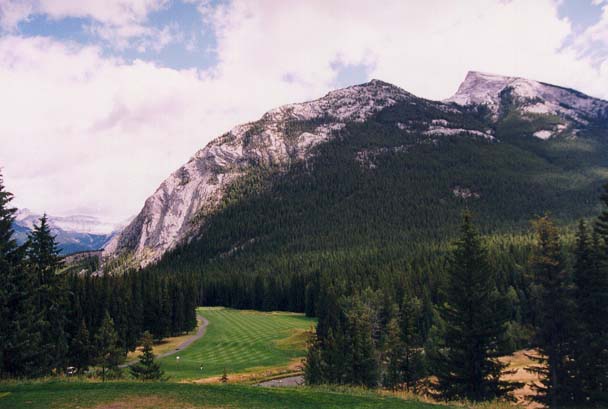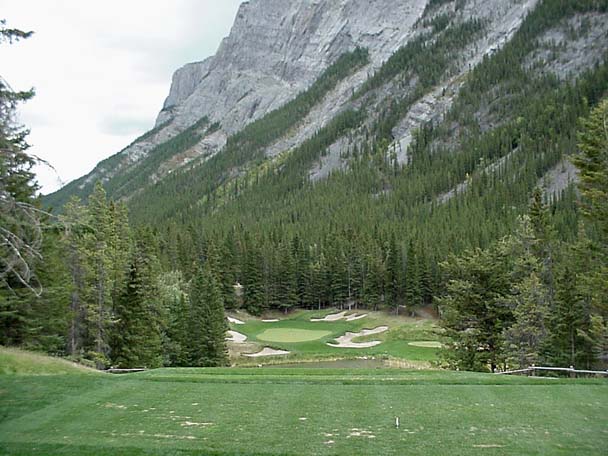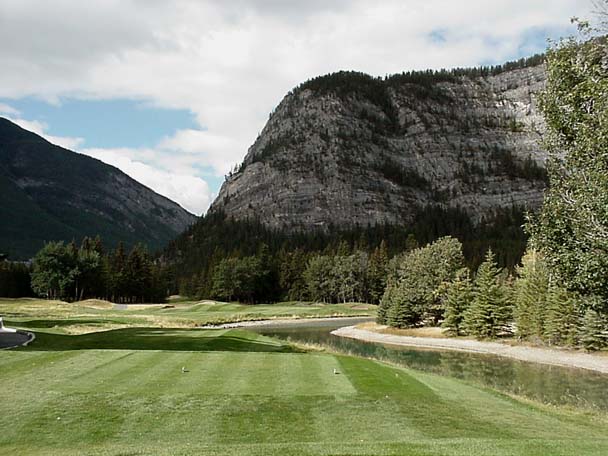Banff: Still One of the World’s Greats
by Ben Dewar

What once was Canada’s best finishing hole is now the 14th. The incomparable Banff Springs hotel looms in the distance.
Originally built in 1927 by the Canadian Pacific Railway, the Banff Springs Golf Course was expanded to 27 holes in 1992, when golf architect Bill Robinson added nine new holes to Stanley Thompson’s original 18 hole course.
While the Thompson 18 remains intact, a new clubhouse, also built in 1992, located in the middle of the original course, has caused a change in the numbering of the holes and the flow of Thompson’s original design which, in part, caused Banff Springs to fall from 5th to 45th in SCORE Golf’s rankings of the top 100 Canadian courses between 1992-2001.
The following is an explanation of the old eighteen vs. the new:
| After the renumbering | |
| 1 (Formerly 5) | 432 yards |
| 2 (Formerly 6) | 179 |
| 3 (Formerly 7) | 536 |
| 4 (Formerly 8) | 199 |
| 5 (Formerly 9) | 431 |
| 6 (Formerly 10) | 381 |
| 7 (Formerly 11) | 610 |
| 8 (Formerly 12) | 158 |
| 9 (Formerly 13) | 510 |
| 10 (Formerly 14) | 225 |
| 11 (Formerly 15) | 424 |
| 12 (Formerly 16) | 449 |
| 13 (Formerly 17) | 232 |
| 14 (Formerly 18) | 447 |
| 15 (Formerly 1) | 480 |
| 16 (Formerly 2) | 421 |
| 17 (Formerly 3) | 384 |
| 18 (Formerly 4) | 585 |
The original sequence of the golf course was lost in the renumbering, most notably the stretch of finishing holes as well as the wonderful opening hole. While the present dayholes 10-15are still one of the great stretches of golf in Canada (and around the world for that matter), its impact of providing athrilling finish has been obviously altered. These five holes are made up of two long par threes (10 and 13) and three par fours (11, 12, and 14). To compound the challenge,these fiveoften play into the wind.
Also, the original first hole (Thompson’s tee was only 432 yards, not the newer 480 tee, which was added prior to the 1992 renovation, is now the 15th,and made for a great start, with onlookers from the hotel adding to the tension of the first tee shot.

Formerly the opening hole, today’s 15th hole is still one of the strongest (and certainly most breathtaking) holes anywhere. This former opener instilled the golfer with excitement from the first shot, something the current opener fails to do.
However, even with the re-numbering,Banff remains comparable to Thompson’s other four world class courses:nearby Jasper Park, Capilano, Highlands Links, and St. George’s. Banff has all the ingredients of a great golf course, and maintains some of the bestexamples of Thompson bunkering.
Among the par threes, four is the headliner: the famed Devil’s Cauldron hole (originally the 8th). Its first view leaves nothing to the imagination. The original hole played approximately 165 yards, but a new tee has been added (in the 1992 renovation) further back to create a longer and more elevated hole. The hole falls steeply downhill to a green with a plethora of surrounding bunkers. The glacial lake short of the hole and the mountains above are placed around the hole and help to create one of the most scenic par threes in the world. Not surprisingly the hole receives a great deal of acclaim, perhaps the highest honour for a designer whose par threes are often the highlights of his work.

The famous Devil’s Cauldron
The other par threes at Banff are the second, eighth, tenth and thirteenth (originally 6, 12, 14 and 17).

Thompson keep Donald Ross’s 2nd hole green placement.
The second hole is the only hole from Donald Ross’s original Banff Springs course and remains a strong, uphill, mid-length par three, with great bunkers guarding the green. Eight, meanwhile, is a great short par three, with a pond in front and a quirky green that is a compliment to such a length hole.
The aforementioned tenth is the beginning of the old ‘great stretch’ of closing holes – playing to 225 yards, the hole is masterful. The Bow River snakes in front of the tee before working back to the right side of the green, while a large bunker guards the left side. The preferred shot is clearly a draw off the tee to the small opening in front. However – and this is Thompson’s genius – while the green is receptive to a draw, the golfer needs nerves of steel to set up the draw over the river.

The 10th plays over the elbow of the Bow River.
The last par three isa brute as well. The thirteenth offersgolfers an avenue into the deep and somewhat narrow green with a run-up shot, however Thompson’s trademark bunkering flanks the green on the right and left, awaiting those slightly off line. The wind often lengthens the hole from its already devilish 232 yards.
As a set of five, these par threes show great variety and imagination. They measure 179, 192, 158, 225, and 232 respectively, and each hole has a different strategyas well as a slightlydifferent wind direction. The demand on the golfer to shape a variety of shots is also necessary here, with a draw, fade, pitch, draw and fade sequence working best. This five would rival any set of par 3s on Thompson’s resume.
The par fours at Banff Springs, as they stand today, are a relatively long group, with the shortest measuring 381 yards (this hole was originally 349 yards, though there were still only two par four under 400 yards) and the longest 480. The highlights among the bunch are 5, 11, 12, 14 and 15.
Five does an admirable job of following the ‘Cauldron’. Measuring 432 yards, this hole is the farthest you get from the hotel and marks the turn home. It was the ninth in the former configuration. The left side of the hole is fraught with trouble, and the green complex, highlighted by the bunkers surrounded by fescue, poses an ample challenge for the approach.
Eleven is an underrated hole, mainly due to the disdain of the tree on the right side of the fairway. One local stated he would rather be in the bunkers on the right side of the tree than in the left rough, as the green runs diagonally forcing a high shot to a shallow green, as opposed to a shot to an open and deep green, from the right. At only 424 yards, this hole may not sound intimidating on paper but it proves more challenging into the wind.
Twelve is a long dogleg right that produces the first glimpse of the hotel – a magical backdrop. As one accomplished writer (read Jeff Mingay) pointed out, the significance of this finish can be related to coming home at St. Andrews, to the point that the routing is similar with the nine out, nine back. The bunker on the left side of the fairway is the bailout area, but does not allow the golfer the opportunity to play to the green because of the steep face and distance. Evergreens provide protection for the right side and make going long serious trouble.
Fourteen, which under the former setup was considered by many as Thompson’s finest finishing holes, is quite brilliant. The dogleg right reveals the rugged bunkering and beautiful shapes, and tries to draw golfers towards trouble off the tee, then offers them benefits on their approach shots if they successfully negotiate the hazards. The safe route provides the golfer with a good shot at bogey, but requires the good golfer to directly challenge the bunkers on both shots to negotiate par. With the hotel in the background, the adrenaline rush must be controlled, as the hole demands two solid shots to reach the green.
Fifteen is the last of the great par fours and is aptly named Spray. The Spray River must be crossed with a modest tee shot to the fairway well below. Once again, the preferred line is to take the ball down the left tree line, but the slightest miss will leave the golfer stymied. The fairway offers its greatest width on the right side, making the hole play longer and forcing an approach over the greenside bunkers on the right. While many locals bemoan the moving of the original 432-yard tee to the greatly elevated 480-yard tee, the character of the hole is not changed from the new tee, only the close proximity to the former clubhouse (note: this was not a part of the changes in 1992).
Lastly, examination shows the par fives to be perhaps Banff’s only weakness, at least relative to Thompson’s other four masterpieces. They come as three on the front nine (along with the three par threes) and one on the back nine (holes 3, 7, 9 and 18).
The third, originally the 7th, is a rather neat par five that doglegs right around the mountain, again providing two distinct angles to the hole and a classic risk/reward par five. The drive should play as close to the right without being blocked by hillside, two well shaped shots will leave the golfer with an eagle putt.
Seven has a recently added long tee of 610 yards. Thompson’s intention was always to retain this as the longest par five as evidenced by the great bunkering that plays directly in the line of play, some 130 yards from the green. The open front is conducive to running shots, and once again bunkers flank this relatively small green.
Nine is the most interesting of the par fives, with a grass bunker running the length of the right side of the hole; filled with fescue grass it proves a worthy adversary. The hole exhibits ‘Cape’characteristics, from tee to green, with the most advantageous line off the tee being the riskiest. This bunker is three to four feet lower than the fairway, meaning the short line to the hole is once again the line closest to the hazard. The Bow River flows along the right side of the hole and comes into play on the approach, measuring only two paces from the right edge of the green.
The final par five plays as the finishing hole in the current set up. Playing to 585 yards, the original fourth hole is reachable when the wind is helping. Once again, bunkering pinches the landing area for the approach, a solid par five.
The par threes are superior to the set at Highlands Links (if that excellent course has a weakness, this is where it must lie in that it doesn’t have a ‘great’ one) and Jasper Park (the indifferent seventh and 12th holes are low points), while the long par fours could rival any in Thompson’s collection. This leaves Banff’s par fives, which do not stand up to The Highlands (which in fairness are among the world’s best). However, they are superiorto Jasper Park’s and Cataraqui’s respective sets of three-shot holes.
Compared toHighlands Linksand St. George’s, Banff also does lacka quality short par four. While Thompson did not always include a short par four, his two par fours under 400 yards at Banff (6 and 17) are two of the more indifferentholes there.
All things considered, the weaknesses of Banff are paltry compared to the strengths of the course.

As seen at the 12th, the rugged look of the fescue contrasts the bunkers and the grass.
Banff possesses the characteristics of a wonderful course with great holes complimented by excellent maintenance practices. The maintenance of the course today highlights Thompson’s artful work wonderfully. The contrast between the yellow fescue grasses that surround the bunkers throughout and the fairway grass is seamless and beautiful. The use of fescue is a delightful change from the modern push towards wall-to-wall conditioning; aside from contrast, it provides a challenge to surrounding bunkers as well as the rough.
The bunkers at Banff Springs are among the closest to Thompson’s trademark idea of bunkering, reason enough to cherish the course. The need to tack around the bunkers, or take a direct line over them, is always prevalent. The lines of play revolve around the bunkers, and they are very strong on the less dramatic holes. The bunkering on the dogleg fifth hole is a perfect example, the drive must challenge the inside bunker, or forces a longer route to the hole and second shot over and equally menacing greenside bunker.

The ideal tee ball on the 5th skirts past this bunker on the inside of the dogleg.
The greens, despite the difficult conditions under which the greenskeeping staff is forced to grow grass, (mountain environment with long shadows, long winters and less than ideal soil conditions) are in great condition.Combine this with one of the most spectacular settings in the world for golf and you have Banff Springs Golf Course – one of Canada’s best layouts to be sure.
Would Banff Springs be better with its original sequence of holes intact? Absolutely! Does the course still deserve to be considered among the best in Canada? That is best answered by the response of one individual who, when he was told that Banff was 45th on Score’s list asked ‘Did Thompson design 44 other courses in Canada?’
The End







